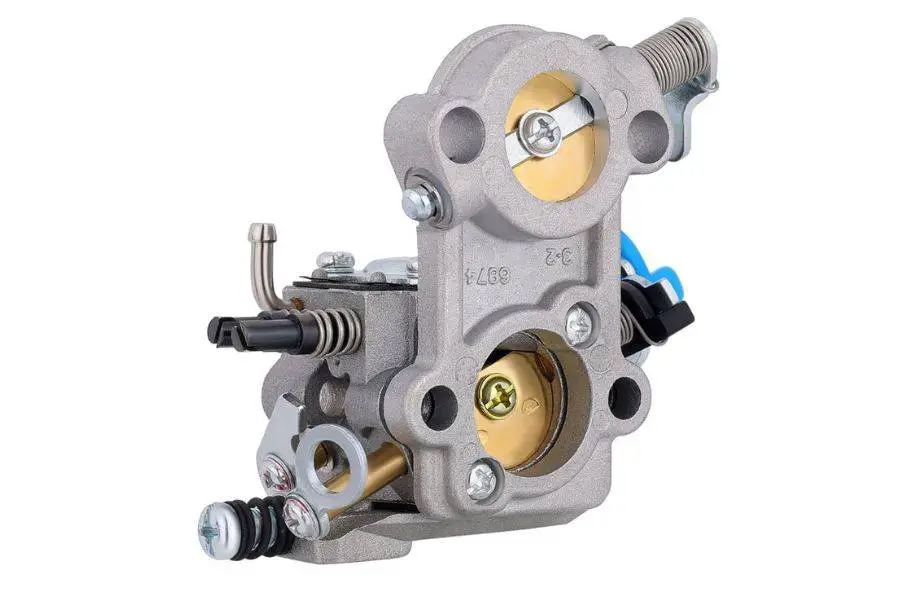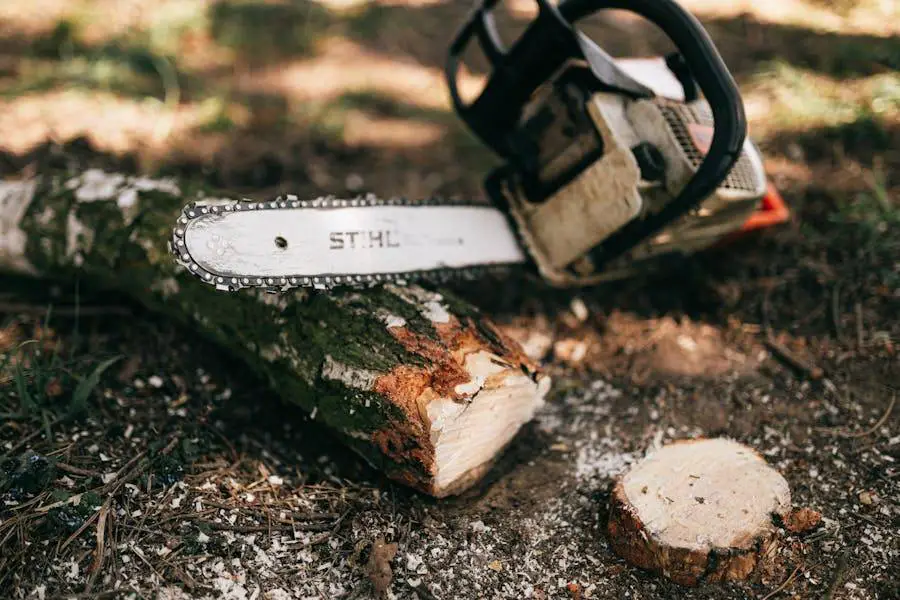Table of Contents
The Husqvarna 455 Rancher is a robust, reliable chainsaw designed for demanding work by landowners and professionals alike.

Central to its performance is the carburetor, a device that blends air and fuel in the perfect ratio for combustion.
However, over time, adjustments may be needed to accommodate changes in air density, fuel quality, or after cleaning and repair work.
This guide provides a comprehensive overview of adjusting the carburetor on your Husqvarna 455 Rancher, including preparation, the adjustment process, maintenance tips, troubleshooting common issues, and additional considerations for ensuring long-term durability and optimal performance.
Understanding the Basics of Carburetion in Chainsaws
The Role of the Carburetor in Engine Performance
The carburetor is pivotal in managing the engine’s speed and power output. It mixes the air and fuel in a precise ratio necessary for efficient combustion.
An improperly adjusted carburetor can lead to poor engine performance, increased emissions, and even damage.
Key Components of the Carburetor
Understanding the components of the carburetor, such as the throttle valve, venturi, and adjustment screws, is crucial.
The throttle valve controls the amount of air-fuel mixture entering the engine.
The venturi helps in maintaining the correct air pressure, while the adjustment screws fine-tune the fuel mixture for various operating conditions.
Preparing for Carb Adjustment on Your Husqvarna 455 Rancher
Necessary Tools and Equipment
You’ll need a screwdriver for the adjustment screws, a tachometer to measure engine speed, and standard protective gear.
Ensure you have a clean, well-lit workspace and disable the chainsaw’s ignition system to prevent accidental starts.
Safety Measures and Precautions
Safety cannot be overstated. Work in a ventilated area, wear gloves and eye protection, and ensure the chainsaw is cool to the touch before starting adjustments.
Familiarize yourself with the chainsaw’s manual for specific safety warnings.
Step-By-Step Carburetor Adjustment Process

Locating the Adjustment Screws
Start by identifying where the Low (L), High (H), and Idle (T) adjustment screws are on your Husqvarna 455 Rancher.
These are typically located on the side of the carburetor.
The L screw is for adjusting the fuel mixture at low speed, the H screw adjusts the high-speed fuel mixture, and the T screw controls the idle speed.
Cleaning Before Adjusting
Ensure that the area around the adjustment screws is clean to prevent debris from entering the carburetor during adjustment. Use compressed air or a soft brush to clear away any dirt.
Starting the Engine
Before making any adjustments, the engine needs to be warmed up. Start your chainsaw and let it run for a few minutes. A warm engine will give more accurate adjustment results.
Adjusting the Low-Speed Screw (L)
- Turn the L screw clockwise until it gently seats. Be careful not to over-tighten.
- Now, turn the screw counterclockwise 1 turn as a baseline setting.
- With the engine running, slowly adjust the L screw counterclockwise until the engine runs smoothly at low speed. Listen for a steady, deep sound.
- If the saw seems to bog down or struggles to stay running, slightly turn the screw clockwise until the engine idles smoothly without stalling.
Setting the High-Speed Screw (H)
- Begin with the H screw 1 turn open from a gently seated position.
- Increase the engine throttle to full. Carefully adjust the H screw counterclockwise until you hear a smooth, high-pitched sound indicating the engine is running efficiently at high speed.
- To prevent the engine from running too lean (which can cause damage), slightly enrich the mixture by turning the screw clockwise until the engine sound is robust and smooth but not overly rich.
Adjusting the Idle Speed Screw (T)
- With the engine running, turn the T screw clockwise to increase the idle speed or counterclockwise to decrease it.
- Adjust this screw until the engine idles smoothly without the chain moving on the bar.
- The goal is to find the sweet spot where the engine runs at idle without stalling but with enough speed to prevent the chain from engaging.
Fine-Tuning for Optimal Performance
After making the initial adjustments, you may need to fine-tune:
- Revisit the L screw to ensure that the transition from idle to full throttle is smooth and without hesitation.
- Adjust the H screw slightly if needed to optimize performance at full throttle.
- Double-check the T screw adjustment to ensure the chainsaw idles well and the chain does not move when the engine is idling.
Checking the Adjustment
Once you have made your adjustments:
- Test the chainsaw by making a few cuts. The engine should run smoothly, accelerate quickly without hesitation, and return to a stable idle.
- If any issues arise during testing, such as stalling or poor performance, revisit the respective adjustment screw(s).
Final Verification

After completing your cuts and ensuring the chainsaw operates as expected, turn off the engine and allow it to cool.
Once cooled, restart the engine to verify that it starts easily and idles smoothly, confirming that your adjustments have been successful.
Signs of Properly Tuned vs. Improperly Tuned Carburetor
A well-tuned carburetor leads to smooth acceleration, a clear sound at high RPMs without sputtering, and a stable idle.
Signs of improper tuning include difficulty starting, poor acceleration, excessive smoke, or an engine that dies at idle.
Maintenance Tips to Keep Your Carburetor in Top Condition
Routine Cleaning and Inspection
Regularly clean the air filter and inspect the carburetor for dirt or deposits. Use carburetor cleaner spray and compressed air for cleaning, being careful not to dislodge any small parts.
When to Replace Carburetor Components
Over time, components like the diaphragm, gaskets, and needles can wear out. If cleaning doesn’t resolve performance issues, replacement might be necessary. Always use genuine parts for replacement.
Troubleshooting Common Issues After Adjustment
Engine Starting Problems
If the engine does not start or runs poorly after adjustment, double-check the settings of the L and H screws. Also, ensure there are no clogs in the fuel line or filter.
Irregular Idle and Performance Hitches
Irregular idle or performance issues may indicate a vacuum leak, possibly from a cracked fuel line or an improperly seated carburetor. Inspect for physical damage and ensure all connections are tight.
Additional Considerations for Long-Term Durability
Fuel Selection and Storage
Use fresh, high-quality fuel mixed with the correct oil ratio, as stale fuel can clog the carburetor.
Storing the chainsaw with old fuel in the tank can lead to starting difficulties and may require more frequent carburetor adjustments.
The Impact of Ethanol on Carburetor Performance
Ethanol-blended fuels can attract moisture and form deposits in the carburetor.
Whenever possible, use ethanol-free gasoline or minimize the chainsaw’s exposure to such fuels to preserve carburetor health.
Conclusion
Adjusting the carburetor on your Husqvarna 455 Rancher is a crucial aspect of maintenance that ensures optimal performance, longevity, and reliability.
By understanding the basics, preparing properly, and following the detailed steps for adjustment and maintenance, you can keep your chainsaw running smoothly for years to come.
Remember, patience and precision are key to a successful adjustment process.


![DIY Snow Shovel [Step-By-Step Guide] DIY Snow Shovel [Step-By-Step Guide]](https://homesteadandprepper.com/wp-content/uploads/2022/07/Making-homemade-snow-shovel-150x150.jpg)

![How To Fix A Loose Light Switch [Step-by-step] How To Fix A Loose Light Switch [Step-by-step]](https://homesteadandprepper.com/wp-content/uploads/2021/08/How-To-Fix-A-Loose-Light-Switch-150x150.jpg)



![How To Build A Four-Season Room On A Deck [Guide] How To Build A Four-Season Room On A Deck [Guide]](https://homesteadandprepper.com/wp-content/uploads/2021/04/How-to-build-a-four-season-room-on-a-deck-150x150.jpg)